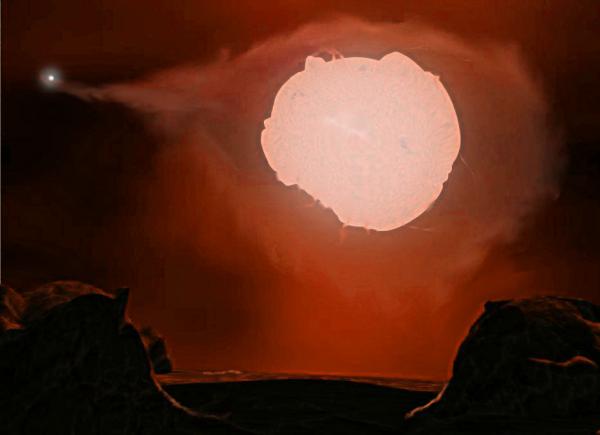BY LETTER
M-Type Star
Red Giant | |
 Image from Steve Bowers | |
| Mira, a red giant, is irregular both in shape and in luminosity | |
The spectral class M includes main sequence red dwarfs as well as much less common, but much brighter, red giant stars which have left the main sequence. Some red giants are among the brightest stars in the sky.
Red Dwarf | |
 Image from Steve Bowers | |
| Barnard's Star, a main sequence red dwarf | |
The small, cool, red dwarf is the faintest in the sequence of spectral types, but also by far the most common type of star in the galaxy. These dim stars are distinguished by strong absorption bands of titanium oxide and many metallic lines.
The statistics for M type stars are given below:
Spectral type M0 :: Luminosity 0.1 x Sol :: Temperature 3,500 K :: Mass 0.5 x Sol :: Radius 0.6 x Sol :: Density 2.5 gm/cm3
Spectral type M5 :: Luminosity 0.01 x Sol :: Temperature 2,800 K :: Mass 0.2 x Sol :: Radius 0.3 x Sol :: Density 10 gm/cm3
Spectral type M8 :: Luminosity 0.001 x Sol :: Temperature 2,800 K :: Mass 0.2 x Sol :: Radius 0.1 x Sol :: Density 63 gm/cm3
These small dim stars are so slow burning that even the brightest will continue on the main sequence for some 56 billion years; dimmer examples will last more than a trillion years.
Considered the plebeian commoners of the galaxy because of their dim output of light and heat, and hence passed over by the bigger terraforming. and colonization groups, and appropriated by empires only for strategic regions, these stars nevertheless are just as likely as any other to have solar systems and their fair complement of planets, asteroids and comets. They often selected therefore by smaller clades and polities, by hyperturings and vecs, even by hiders, idealists and other eccentric groups. Most of these solar systems are never connected to the wormhole nexus, and many are visited only rarely by relativist traders. In a sense, the vast mass of M type stars constitute the vast little-travelled hinterlands of the galactic civilization, although even they are well visited and well served in relation to the even more common but often completely hidden masses of brown dwarfs and free-wandering planets in the interstellar depths.
Related Articles
Development Notes
Text by M. Alan Kazlev
Initially published on 08 December 2001.
Initially published on 08 December 2001.






